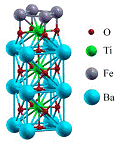Department of Physics and Astronomy: Publications and Other Research

Evgeny Tsymbal Publications
ORCID IDs
Tsymbal http://orcid.org/0000-0002-6728-5510
Document Type
Article
Date of this Version
2010
Citation
Physical Review B (2010) 81: 104419
Abstract
Using a ferroelectric barrier as a functional material in a (magnetic) tunnel junction has recently attracted significant interest due to new functionalities not available in conventional tunnel junctions. Switching a ferroelectric polarization of the barrier alters conductance resulting in a tunneling electroresistance (TER) effect. Using a ferroelectric barrier in a magnetic tunnel junction makes it mutiferroic where TER coexists with tunneling magnetoresistance (TMR). Here we develop a simple model for a multiferroic tunnel junction (MFTJ) which consists of two ferromagnetic electrodes separated by a ferroelectric barrier layer. The model explicitly includes the spin-dependent screening potential and thus extends previously developed models for FTJs and MFTJs. Our results demonstrate that the effect of spin-dependent screening may be sizable and may provide significant contributions to TMR and TER in MFTJs. We find that, similar to FTJs with a composite (ferroelectric/dielectric) barrier layer, the TER in a MFTJ with such a barrier is dramatically enhanced indicating that the resistance ratio between the states corresponding to the opposite polarization orientations may be as high as 104 and even higher. Our results demonstrate the possibility of four resistance states in MFTJs with a pronounced difference in resistance and a possibility to control these resistance by an electric field (through ferroelectric polarization of the barrier) and by a magnetic field (through magnetization configuration of the electrodes). These functionalities may be interesting to device applications of MFTJs.


Comments
Copyright © 2010, American Physical Society. Used by permission